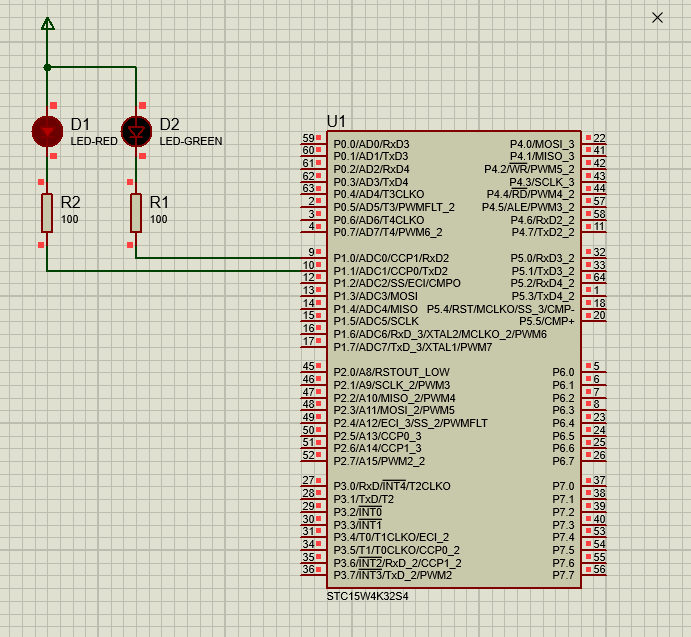楼主 # 2021-10-28 18:30:32 分享评论
51单片机的一个多线程编程模型
Protothread 一个非常巧妙的轮询式多线程模型,也是 contiki 系统的内核,uip 和 lwip 作者 adam 的杰作
http://dunkels.com/adam/
proteus8.12.SP0 居然都支持 STC 51 单片机和 STM32 模拟了。。
https://www.52pojie.cn/thread-1432924-1-1.html
链接:https://pan.xunlei.com/s/VMZq3HdA1_aoTPXmaYi4SkLsA1
提取码:p9qc
常见问题:
一、proteus 8.12_sp0和proteus_8.9sp2存在相同的问题,如果安装在非C盘目录下,打开后则会显示密钥错误和未注册的灰色字体;点击帮助后也是未注册。
这是因为破解器默认是你安装在C盘。
解决方法如下:
[1]、卸载后重装在C盘
[2]、1.先在C盘安装,破解.
2.打开软件,发现有注册信息,则注册成功
3.此时软件复制根目录的bin文件夹。
4.卸载刚才安装的proteus
注意:不要用第三方的卸载软件,在控制面版里卸载就行,更不要用everything之类的把残余文件删的干干净净
5.重新安装,选择D盘。破解
6.把刚才复制bin文件夹覆盖到D盘软件的根目录下,选择全部替换
7.再打开proteus就显示注册成功了
-- 虽然有点脱裤子放屁的感觉,但能用就行
Protesu 仿真测试,两个线程控制 LED 闪烁,另外还有 mutex timer 等,可以参考 contiki 的内核实现。
仿真截图:
示例工程:
STCxx_Projects.rar
测试代码:
/**
******************************************************************************
* @file main.c
* @author Iron
* @date 2021-01-01
* @version v1.0
* @brief main c file
*/
/* Private includes ----------------------------------------------------------*/
#include "board.h"
#include "pt.h"
#include "delay.h"
/* Private define ------------------------------------------------------------*/
/* Private macro -------------------------------------------------------------*/
/* Private typedef -----------------------------------------------------------*/
/* Private variables ---------------------------------------------------------*/
/* Two flags that the two protothread functions use. */
static int protothread1_flag, protothread2_flag;
/* Private function prototypes -----------------------------------------------*/
/**
* The first protothread function. A protothread function must always
* return an integer, but must never explicitly return - returning is
* performed inside the protothread statements.
*
* The protothread function is driven by the main loop further down in
* the code.
*/
static int protothread1(struct pt *pt)
{
/* A protothread function must begin with PT_BEGIN() which takes a
pointer to a struct pt. */
PT_BEGIN(pt);
/* We loop forever here. */
while (1)
{
/* Wait until the other protothread has set its flag. */
PT_WAIT_UNTIL(pt, protothread2_flag != 0);
/* thread code... */
led_togger(LED0);
delay_ms(100);
/* We then reset the other protothread's flag, and set our own
flag so that the other protothread can run. */
protothread2_flag = 0;
protothread1_flag = 1;
/* And we loop. */
}
/* All protothread functions must end with PT_END() which takes a
pointer to a struct pt. */
PT_END(pt);
}
/**
* The second protothread function. This is almost the same as the
* first one.
*/
static int protothread2(struct pt *pt)
{
PT_BEGIN(pt);
while (1)
{
/* Let the other protothread run. */
protothread2_flag = 1;
/* Wait until the other protothread has set its flag. */
PT_WAIT_UNTIL(pt, protothread1_flag != 0);
/* thread code... */
led_togger(LED1);
delay_ms(100);
/* We then reset the other protothread's flag. */
protothread1_flag = 0;
/* And we loop. */
}
PT_END(pt);
}
/**
* Finally, we have the main loop. Here is where the protothreads are
* initialized and scheduled. First, however, we define the
* protothread state variables pt1 and pt2, which hold the state of
* the two protothreads.
*/
static struct pt pt1, pt2;
int main(void)
{
board_init();
/* Initialize the protothread state variables with PT_INIT(). */
PT_INIT(&pt1);
PT_INIT(&pt2);
/*
* Then we schedule the two protothreads by repeatedly calling their
* protothread functions and passing a pointer to the protothread
* state variables as arguments.
*/
while (1)
{
protothread1(&pt1);
protothread2(&pt2);
}
}
/**
* @}
*/
/******************* (C)COPYRIGHT 2021 ***** END OF FILE *********************/离线
感谢为中文互联网持续输出优质内容的各位老铁们。
QQ: 516333132, 微信(wechat): whycan_cn (哇酷网/挖坑网/填坑网) service@whycan.cn
太原小智科技有限责任公司 - 东莞哇酷科技有限公司联合开发
太原小智科技有限责任公司 - 东莞哇酷科技有限公司联合开发